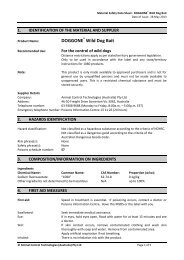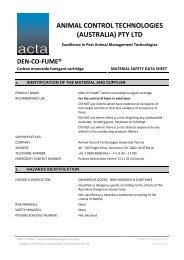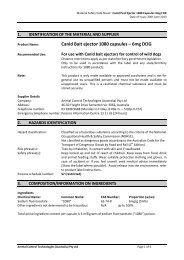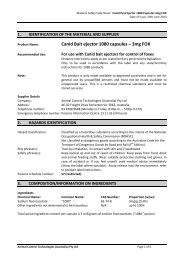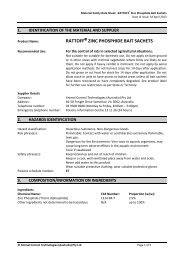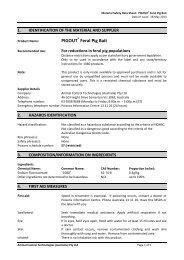RABBAIT ® 1080 Oat Bait MSDS - Animal Control Technologies
RABBAIT ® 1080 Oat Bait MSDS - Animal Control Technologies
RABBAIT ® 1080 Oat Bait MSDS - Animal Control Technologies
You also want an ePaper? Increase the reach of your titles
YUMPU automatically turns print PDFs into web optimized ePapers that Google loves.
Material Safety Data Sheet: <strong>RABBAIT</strong> <strong>®</strong> <strong>1080</strong> <strong>Oat</strong> <strong>Bait</strong><br />
Date of Issue: 1 June 2008<br />
1. IDENTIFICATION OF THE MATERIAL AND SUPPLIER<br />
Product Name: <strong>RABBAIT</strong> <strong>®</strong> <strong>1080</strong> <strong>Oat</strong> <strong>Bait</strong><br />
Recommended Use: For the control of rabbits<br />
Distance restrictions apply as per state/territory government legislation.<br />
Only to be used in accordance with the label and any state/territory<br />
instructions for <strong>1080</strong> products.<br />
Note: This product is only made available to approved purchasers and is not for<br />
general use by unqualified persons and must not be made available to<br />
unapproved users. This is a restricted chemical substance and must be stored<br />
securely.<br />
Supplier Details<br />
Company: <strong>Animal</strong> <strong>Control</strong> <strong>Technologies</strong> (Australia) Pty Ltd<br />
Address: 46-50 Freight Drive Somerton Vic 3062, Australia<br />
Telephone number: 03 9308 9688 (Monday to Friday, 8:00a.m. – 5:00p.m.EST)<br />
Emergency telephone number: Poisons Information Centre 13 11 26 (24 hours)<br />
2. HAZARDS IDENTIFICATION<br />
Hazard classification: Not classified as a hazardous substance according to the criteria of NOHSC.<br />
Not classified as a dangerous good according to the criteria of the Australian<br />
Dangerous Goods Code.<br />
Risk phrase(s): None<br />
Safety phrase(s): None<br />
Poisons schedule number: S7<br />
3. COMPOSITION/INFORMATION ON INGREDIENTS<br />
Ingredients<br />
Chemical Name: Common Name: CAS Number: Proportion (w/w):<br />
Sodium fluoroacetate “<strong>1080</strong>” 62-74-8 0.4g/kg<br />
Other ingredients not determined to be hazardous N/A up to 100%<br />
4. FIRST AID MEASURES<br />
First aid: Speed in treatment is essential. If poisoning occurs, contact a doctor or<br />
Poisons Information Centre. Have this <strong>MSDS</strong> or the label with you.<br />
Swallowed: Seek immediate medical assistance.<br />
Eye: If in eyes, hold eyes open, flood with water for at least 15 minutes and see a<br />
doctor.<br />
Skin: If skin contact occurs, remove contaminated clothing and wash skin<br />
thoroughly with soap and water. Remove from contaminated area.<br />
Apply artificial respiration if not breathing.<br />
Inhaled: There is no inhalation risk with the product.<br />
Advice to doctor: The bait contains 0.04% w/w (0.4g/kg) sodium fluoroacetate. Sodium<br />
fluoroacetate is also known as ‘Compound <strong>1080</strong>’.<br />
© ANIMAL CONTROL TECHNOLOGIES Pty Ltd Page 1 of 4
Material Safety Data Sheet: <strong>RABBAIT</strong> <strong>®</strong> <strong>1080</strong> <strong>Oat</strong> <strong>Bait</strong><br />
Date of Issue: 1 June 2008<br />
It is important to ascertain the route of exposure and the quantity of bait exposed to. Sodium fluoroacetate is<br />
readily absorbed by the oral route and acts after metabolic conversion to fluorocitrate by blocking enzymes<br />
in the tricarboxylic acid cycle inhibiting metabolic energy production. Organs with high energy<br />
requirements such as the heart, diaphragm and brain are most affected. Accumulation of citrate and<br />
disturbances in calcium ion levels can lead to symptoms. Early symptoms may include nauseas, vomiting,<br />
stomach pains, tingling of the nose, numbness of the face, nervousness. More sever symptoms include,<br />
convulsions, Laboured breathing, excitability, hallucinations and heart attack. Treat symptomatically and<br />
supportively. Monitor for electrolyte abnormalities and metabolic acidosis. If caught early induce vomiting,<br />
if not emesis if contraindicated because of the potential for arrhythmia and convulsions. Consult poisons<br />
control for most up to date information. Sodium fluoroacetate is not readily absorbed through skin and is<br />
very water soluble prompt washing in soapy water will minimise risk after accidental skin exposure<br />
5. FIRE FIGHTING MEASURES<br />
Fire & explosion hazards: The bait is not flammable and will not auto-ignite.<br />
Suitable extinguishing media: Water, foam, powder<br />
Hazards from combustion: None applicable<br />
Special protective equipment: Respirator, filter A/P<br />
6. ACCIDENTAL RELEASE MEASURES<br />
Spills and Disposal: Sodium fluoroacetate is water soluble. While wearing elbow-length PVC<br />
gloves, sweep-up spilt bait using a broom and shovel and place in sealed<br />
containers. Bury contaminated waste and excess product below 500 mm.<br />
Triple rinse and bury rinsate and empty containers in a local authority<br />
landfill. If no landfill is available, bury the containers below 0.5m in a<br />
disposal pit specifically marked and set up for this purpose clear of<br />
waterways, desirable vegetation and tree roots. Empty containers should not<br />
be burnt. Do NOT re-use containers for any other purpose. Sodium<br />
fluoroacetate is readily degraded by common soil bacteria and moulds.<br />
Wash any contaminated areas with soapy water and bury rinsate from<br />
washed areas.<br />
7. HANDLING AND STORAGE<br />
Precautions for safe handling: To avoid risks for man and environment the instructions for use are to be<br />
followed. Avoid all contact with the product and wear protective clothing<br />
and gloves<br />
Conditions for safe storage: Store in the closed, original container in a dry, cool, well ventilated area out<br />
of direct sunlight. Store in a locked room or place away from children,<br />
animals, food, feedstuffs, seed and fertilisers.<br />
8. EXPOSURE CONTROLS/PERSONAL PROTECTION<br />
National exposure standards: Exposure standards allocated for sodium fluoroacetate powder are 0.05mg/m 3<br />
Time weighted average. Short Term Exposure Levels are 0.15mg.m 3 . Avoid<br />
direct contact with skin. There is no dust associated with this product.<br />
Biological limit values: No biological limit allocated.<br />
Engineering controls: The product formulation dilutes the concentration of sodium fluoroacetate.<br />
Personal protective equipment: When opening the container and using baits wear elbow-length PVC gloves.<br />
© ANIMAL CONTROL TECHNOLOGIES Pty Ltd Page 2 of 4
9. PHYSICAL AND CHEMICAL PROPERTIES<br />
Appearance: <strong>Oat</strong>s coloured with a blue dye.<br />
pH: Not available<br />
Vapour pressure: Not applicable<br />
Vapour density: Not applicable<br />
Boiling point / range: Not applicable<br />
Freezing / melting point: Not available<br />
Solubility in water: The oat bait is not soluble in water.<br />
10. STABILITY AND REACTIVITY<br />
Material Safety Data Sheet: <strong>RABBAIT</strong> <strong>®</strong> <strong>1080</strong> <strong>Oat</strong> <strong>Bait</strong><br />
Date of Issue: 1 June 2008<br />
Chemical stability: Stable for extended periods under normal storage and handling<br />
conditions.<br />
Incompatible materials: None applicable<br />
Hazardous decomposition products: No specific data<br />
Hazardous reactions: No specific data<br />
11. TOXICOLOGICAL INFORMATION<br />
Acute toxicity: Based on the lowest known lethal dose for humans (0.71 mg/kg bw), an 80 kg<br />
person would have to consume approximately 140g of bait to receive a lethal dose.<br />
Lower doses may still cause toxic effects. There is usually period of latency<br />
between poisoning and onset of symptoms of between 30 minutes and 3 hours.<br />
Neurological effects include convulsion, respiratory depression, tremulousness,<br />
hallucinations and coma. Cardiac effects include, hypertension then hypotension,<br />
arrhythmias, ventricular fibrillation and cardiac failure.<br />
Acute:<br />
Swallowed: Very poisonous if swallowed. Lethal doses can cause cardiac arrest.<br />
Eye: Avoid contact with eyes. Effects not known.<br />
Skin: Avoid contact with skin. Studies with rabbits have shown that <strong>1080</strong> is poorly<br />
absorbed through the skin.<br />
Inhaled: Not applicable to this formulation. There is no inhalation or vapour risk with the<br />
product.<br />
Chronic: Long term exposure at high doses may lead to cardiac and or testicular damage.<br />
Studies into the effects of chronic (90 day) exposure in rats have found damage to<br />
the heart, and in males the testis, at a dose of 0.25mg/kg/day. Though some of this<br />
damage may be reversible over time when exposure is removed.<br />
12. ECOLOGICAL INFORMATION<br />
Do not contaminate streams, rivers or waterways with the chemical or used containers. Information on nontarget<br />
animal distribution, conservation status, habitat preference, diet, tolerance to <strong>1080</strong>, body weight and<br />
size of home range can be used to reduce poisoning risks posed by baiting programs. Time baiting programs<br />
when non-target species are least active or least susceptible. Follow approved label directions to minimise<br />
risks to non-target animals.<br />
Ecotoxicity: Sodium fluoroacetate is toxic to fish but is rapidly diluted in water.<br />
Sodium fluoroacetate is readily degraded by common soil bacteria and<br />
moulds once baits become wet in soil.<br />
© ANIMAL CONTROL TECHNOLOGIES Pty Ltd Page 3 of 4
Material Safety Data Sheet: <strong>RABBAIT</strong> <strong>®</strong> <strong>1080</strong> <strong>Oat</strong> <strong>Bait</strong><br />
Date of Issue: 1 June 2008<br />
Persistence and degradability: The poison and dye coating on the product is biologically degradable and<br />
will not accumulate in soil or water.<br />
13. DISPOSAL CONSIDERATIONS<br />
Break, crush or puncture and dispose of empty containers in a local authority landfill. If no landfill is<br />
available, bury the containers below 500 mm in a disposal pit specifically marked and set up for this purpose<br />
clear of waterways, desirable vegetation and tree roots. Empty containers and product should not be burnt.<br />
14. TRANSPORT INFORMATION<br />
This product is not classified as a dangerous good according to the Australian Dangerous Goods Code 6 th<br />
Edn. (1998).<br />
UN number: Not applicable UN proper shipping name: Not applicable<br />
Dangerous Goods Class: Not applicable Subsidiary Risk: Not applicable<br />
Packing group: Not applicable Hazchem code: Not applicable<br />
15. REGULATORY INFORMATION<br />
Poisons schedule number: S7<br />
16. OTHER INFORMATION<br />
Date of Preparation of this <strong>MSDS</strong>: 1 June 2008<br />
This Material Safety Data Sheet (<strong>MSDS</strong>) has been developed using the following references:<br />
National Code of Practice for the Preparation of Material Safety Data Sheets 2 nd Edn. [NOHSC:2011(2003)]<br />
Australian Dangerous Goods Code 6 th Edn. (1998)<br />
World Health Organisation (2006) WHO-UNEP Sound management of pesticides and diagnosis and<br />
treatment of pesticide poisoning.<br />
Bruère, A.N., Cooper, B.S. and Dillon, E.A. (1990) Veterinary Clinical Toxicology, Continuing Education,<br />
Palmerston North, New Zealand.<br />
Eason, C. and Turck, P. (2002) A 90-day Toxicological evaluation of compound <strong>1080</strong> (Sodium<br />
Monofluoroacetate) in Sprague-Dawley rats, Toxicological Sciences, vol. 69, pp. 439-447.<br />
The physical values and properties described in this <strong>MSDS</strong> are typical values based on scientific literature and<br />
material produced to date, and are believed to be reliable. <strong>Animal</strong> <strong>Control</strong> <strong>Technologies</strong> provides no warranties,<br />
either expressed or implied and assumes no responsibility for the accuracy or completeness of the data contained<br />
herein. The information is supplied upon the condition that the persons receiving information will make their<br />
own determination as to the suitability for their purposes prior to use of this product. Due care should be taken<br />
to ensure that the use of this product and its disposal is in compliance with all relevant Federal, State and Local<br />
Government regulations.<br />
End of <strong>MSDS</strong><br />
© ANIMAL CONTROL TECHNOLOGIES Pty Ltd Page 4 of 4





